Innovation and entrepreneurship and education have become an important topic in China’s higher education. Based on pedagogy theory, this paper divides innovation and entrepreneurship education in universities into three levels: ideological education, innovative education and entrepreneurial education. Innovation is the content of higher education, and it is also the ability that contemporary college students must have. Only with education can there be innovation, only with innovation can there be entrepreneurship, and only with entrepreneurship can there be innovation. This is of great significance to the development of multi-level education, universal education, innovation and entrepreneurship education, and the improvement of education, teaching and child-rearing levels. In order to promote the optimization practice of college students’ innovation and entrepreneurship education, this paper designs a software system which is convenient for college students’ project application, project implementation, data verification and progress report. At the same time, it can help people review and select team members, thus greatly improving management efficiency.
OBE education philosophy emphasizes: what teachers should focus on in teaching design and teaching goal implementation is what kind of results should students achieve in learning? What methods should be used to make students achieve such results? How can we effectively help students achieve results? The results here are It refers to the results achieved by students through a certain stage of learning and the maximum ability they can achieve [1, 2]. The OBE education model is an innovation of education paradigm, and its fundamental is to realize the transformation from “content-oriented” to “student-oriented”. Based on the OBE education concept, in the actual teaching process, teachers often need to carefully design teaching according to the growth goals of different types of students, and constantly innovate learning content, learning activities, teaching forms, etc., and to ensure the improvement of students’ learning outcomes and sense of gain [3,]. Create a teaching environment that enables students to truly learn deeply, and the learning outcomes take student growth as the core goal, especially the design of the learning process through experience and practice, focusing on the acquisition of practical results. Learning outcomes cannot be information and one-sided knowledge and should benefit students for life [4]. Teaching based on the OBE education concept should clearly focus and organize each activity link in education and teaching, so that students can truly grow and become talents in the learning process [5]. As the starting point of innovation, entrepreneurship and education, it has achieved fruitful results and emphasized the challenges and innovations in this new field of education.
Currently, China’s economy and society have entered a new era, wherein cultivating innovative talents serves as an internal requirement and source of strength to facilitate the implementation of the strategic plan for innovative development. It also forms the foundation and core project construction necessary for achieving a leapfrog development in high-quality education in China. In summary, integrating OBE theory into the practical optimization of innovation and entrepreneurship education holds significant theoretical and practical implications for promoting the realization of university talent training goals.
The trend of some documents retrieved through the keyword “innovation, entrepreneurship and education” in recent years can be used to attract scientists’ attention to this issue. As shown in Figure 1.
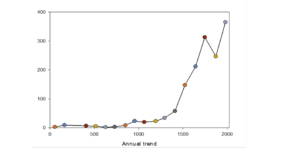
Since 2003, documents related to “Innovation and Entrepreneurship Education” are emerging, opening a precedent for this research. From 2003 to 2009, the number of documents on related topics has reached 9. Our country’s “innovation and entrepreneurship education” research started relatively late [6, 7]. Since 2015, the number of documents has grown exponentially, and the research related to this research topic has begun to show a trend of rapid development. However, it is not difficult to find from the figure that as of 2022, the number of published papers related to this research topic has shown a trend of decreasing, and the number of published papers has dropped by 25% month-on-month.
From a non-utilitarian perspective, Zhou et al. [8] pointed out that the main goals of entrepreneurs to start a business are to change their innovative spirit and ability, to exercise their self-employment professional awareness, and to impart entrepreneurial knowledge and management knowledge. Ge et al. [9] believes that the goals of innovation and entrepreneurship should have broad, universal and long-term significance. According to social reality, school level and category, student conditions, etc., the stratified goals are clearly defined: that is, to cultivate citizens with better entrepreneurial qualities and high-quality entrepreneurs, and at the same time. Ge et al. [9] must take talent training as the origin and end point, in which the curriculum system is the key, and the integration of education of various majors is the difficulty, closely integrated with reality, and adopted various methods to promote the combination. Rose [10] believes that the construction of the curriculum system should design curriculum objectives in layers, and the objectives at each level should highlight the connotation of key literacy [11]. Hero and Lindfors [12] proposed that innovation and entrepreneurship courses should have a specific audience, rather than educating all students one-size-fits-all.
In the current education system, innovation and entrepreneurship education, constructive subject education, curriculum design and teacher education, especially the theory and practice combined with innovation and entrepreneurship education, have achieved a lot of research results. This paper designs a software system which is convenient for college students’ project application, project implementation, data verification and progress report. At the same time, it can help people review and select team members, thus greatly improving management efficiency.
From the perspective of OBE, the resources must be managed according to certain specifications is shown in Figure 2:
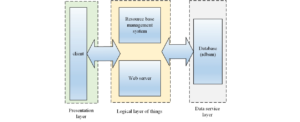
In the process of user data acquisition, the user data in the recommender system comes from the user’s click, download and other behavioral characteristics, the user’s browsing, evaluation and scoring and other data, and the user’s behavioral data can be obtained through explicit scoring and implicit scoring. The traditional five-point feedback scale is used to display scores, and the users’ downloads of resources are converted into implicit scores of resources [13, 14].
In the recommendation algorithm, the cosine similarity has been proved to be a standard metric system due to its precise effect. This metric uses the cosine value of the angle between two-dimension vectors to measure the similarity. As shown in the formula, the user’s ratings for all items can be regarded as a one-dimensional vector. If the user’s rating vectors are and respectively, the user’s cosine similarity is:
Since different users have different interest characteristics, their preferences for resources have strong subjective factors, resulting in different scoring scales. By improving the cosine similarity algorithm, the user’s average score for all resources can be subtracted when calculating the user’s score for the item, so that the similarity calculation is more accurate. The improved cosine similarity formula is as follows:
From the perspective of OBM, after obtaining neighbors of users or items by similarity measurement, if all neighboring users are included, it will not only prolong the calculation time, but also affect the accuracy of recommendation results. There are two commonly used methods for reducing the size of the nearest neighbor set: the fixed value method and the threshold method. The fixed value method limits the size of the neighbors to a fixed value and only considers the nearest neighbors with the highest degree of similarity; the threshold method defines a specific minimum threshold for the similarity, and only selects the nearest neighbors higher than this threshold [15, 16, 17]. There are two potential problems with the method: if the threshold is too high, the neighbor size will be small, which means that many items cannot be predicted; conversely, if the threshold is too low, the neighbor size will not be significantly reduced, as shown in Figure 3:
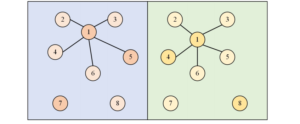
After the similar user group of the target user is obtained, the rating of the target user for the unrated item can be predicted by the ratings of the users in the similar neighbors of the item.
The overall structure of the innovation and entrepreneurship includes several levels, which are the front-end and front-end servers, the application layer, the back end, and the underlying data support services.
As can be seen from the Figure 4, the front-end is mainly some web files. This system uses Django as the front-end, and Django can support the Apache server, so the front-end service uses the Apache server. The application layer is mainly for users. The back end mainly handles database query, addition, deletion, modification, and other functions, as well as file upload and download. The underlying data support mainly uses MySQL database and file management system to support file upload and download [18].
It can be seen from the above that the management application layer based on the OBE perspective is directly used by users, so the functions of the application layer will be directly seen and used by users. Its main modules are data management, project management, declaration management, and message notification. The specific functions are shown in Figure 4:

As can be seen from the Figure 4, data management is mainly user management, assigning users their own permissions, data security and data backup functions, and real-time synchronization of system data to prevent data loss. Project management is mainly about user activation and login. After the system administrator assigns a permission account to it, activation and login begin, project file management and funding allocation, etc., as well as a list of records of the project process. The project declaration is mainly the submission and modification of the project book, the modification of the project according to the review comments, the registration of project information, the registration of specific information into the system, and the list of questions and opinions fed back in the project review [19, 20]. The news notice is mainly to inform the latest news notices about college students’ innovation and entrepreneurship projects issued by the state, a list of the project data that has been applied for before, to prevent repeated applications, etc. The rules and regulations and application instructions are used to stipulate the guidelines that should be followed in the application process, and the rules and regulations that should be followed during the implementation of the project to prevent problems.
According to the project declaration process adopted from the perspective of OBE and the permissions of each user, the interaction between them can be clearly obtained and displayed. As shown in Figure 5 and 6:

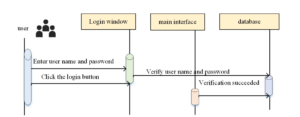
The structure design of table database reflects the logical relationship between entities. Table 1 shows the structure of the system overview:
| Field name | type | Remarks |
|---|---|---|
| Use name | Int [10] | Name, primary key |
| Varchar [11] | mailbox | |
| Phone | Int [10] | Telephone |
| Role | Varchar [11] | Role identity |
| Level | Int [10] | privilege level |
| Name | Varchar [11] | Real name |
| Identity | Int [10] | ID card |
| Company | Varchar [11] | Company |
| Introduction | LONGTEXT | brief introduction |
Table 1 is the main table structure in the database, mainly for the table structure of each user in the system from the perspective of OBE, the items required for the application of innovative projects, the items required for the application of entrepreneurial projects, and the table structure of project management.
From the perspective of OBE, the coupling system is composed of front-end and back-end, which is a complete project management system. The system administrator can assign management rights, such as adding users, deleting users, modifying information, project management, front-end management, publishing announcements and news, system maintenance, system restart, etc. The teachers on the judges are mainly experienced teachers sent by the school to participate in the National College Student Innovation and Entrepreneurship Competition. They mainly review the projects applied for, remind the problems existing in the projects and the content that should be revised, and give appropriate scores and evaluations. Students complete themselves by filling in personal and project information. Students mainly submit project applications, determine participating students and rankings, etc. The project application form is mainly composed of project title, project source, participants, abstract, project background, project content, novelty, assessment indicators, expected results, fund management, risk control, etc. As shown in Table 2.
| Function name | Whether the test passes | remarks |
|---|---|---|
| Permission assignment function | Y | nothing |
| Add user function | Y | nothing |
| Delete user function | Y | nothing |
| Modify information function | Y | nothing |
| Project declaration function | Y | nothing |
| Intermediate inspection or final item uploading function | Y | nothing |
| Approval function | Y | nothing |
| Review function | Y | nothing |
| View history item function | Y | nothing |
| Export function | Y | nothing |
The system database stores permission information, which can dynamically assign permissions. The safety test results are shown in Table 3:
| Test content | Test conditions | Test passed |
|---|---|---|
| Application-level security | Meet the requirements | yes |
| System level security | Meet the requirements | yes |
The system uses the LoadRunner test tool to simulate 30, 80, and 150 users respectively. By running the system, reading data, and testing the response time of functional modules, the corresponding time is recorded each time [21], and the response speed of the system is calculated. It can be known from Table 4.
| minimum value | Maximum | error rate | throughput | |
|---|---|---|---|---|
| Simulate 30 users | 3 | 63 | 0 | 112/min |
| Simulate 80 users | 4 | 283 | 0 | 103/min |
| Simulate 150 users | 6 | 397 | 0 | 89/min |
The users randomly selected in this paper, and the recommended list lengths are 2, 5, 10, 15, and 20 in turn, calculate the precision and recall rate of each user respectively, and then take the average value. The length of the recommendation system performance, the calculated index results and the trend graph are shown in Figure 7. The accuracy rate, recall rate and value of the recommendation system do not fluctuate much, which shows that the recommendation performance based on the OBE perspective is stable, but it can also be seen that the accuracy of the recommendation is not particularly high. This may be due to the fact that the system is currently in the trial operation stage and the number of users is not large, resulting in too few downloads and ratings of resources by users. Further optimization is required in one step of the work.
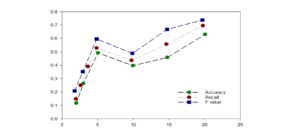
Adopting Outcome-Based Education (OBE) in university innovation and entrepreneurship education is vital. The multi-level approach should focus on public, enhanced, and elite education, catering to diverse needs. However, the existing project management system requires refinement to address student awareness issues and encourage interdisciplinary team formation. The proposed information-based system proves effective, enhancing transparency and collaboration. This study underscores the significance of aligning education with OBE principles for comprehensive learning outcomes, contributing to the ongoing discourse on improving university-level innovation and entrepreneurship education.
No funding is available for this research.
The authors declare no conflict of interests.
1970-2025 CP (Manitoba, Canada) unless otherwise stated.